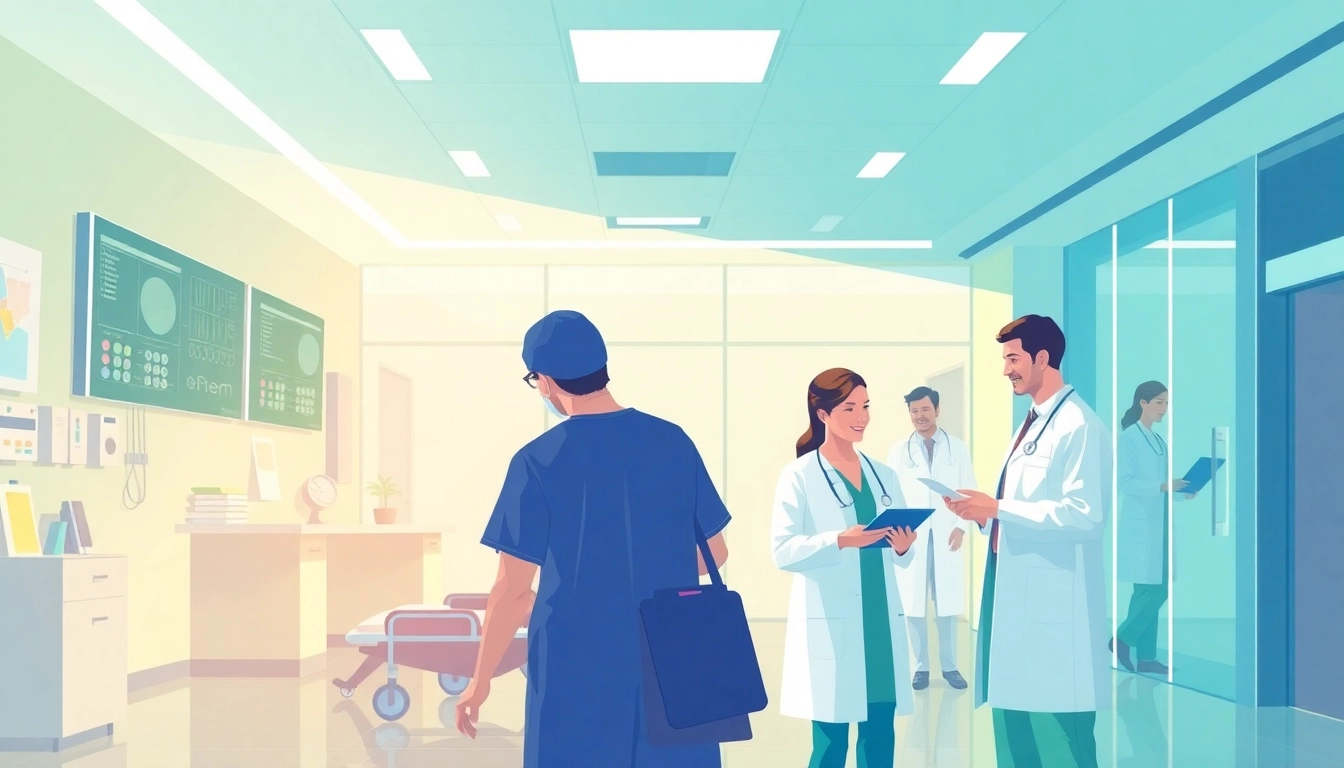Understanding Informatics in Healthcare
In the rapidly evolving landscape of healthcare, the importance of informatics cannot be overstated. Informatics is pivotal in reshaping how healthcare data is utilized, communicated, and transformed into actionable insights. As defined by the www.informaticsview.com, informatics encompasses the science of using data, information, and knowledge to enhance human health and healthcare service delivery. The integration of informatics is not just an added advantage but a necessity for improving patient care, managing healthcare costs, and facilitating efficient healthcare workflows.
Definition and Importance of Informatics
Informatics involves the application of information technology and communication tools to analyze and utilize data in healthcare settings. This field is crucial as it allows healthcare providers to store, retrieve, and manipulate patient information effectively, leading to better decision making. Informatics supports various areas of healthcare, including epidemiology, clinical practice, and population health management.
By leveraging informatics, healthcare providers can improve clinical outcomes through evidence-based practices and reduce errors in patient management. Furthermore, it plays a critical role in research, aiding in the identification of trends and the establishment of best practices that can enhance patient care delivery.
Key Components of Health Informatics
Health informatics is a multi-faceted discipline featuring several key components:
- Electronic Health Records (EHR): Digital versions of patients’ paper charts, EHRs streamline the clinician’s workflow, increase efficiency, and improve access to patient information.
- Clinical Decision Support Systems (CDSS): Assist healthcare providers in making clinical decisions by analyzing data in real time and providing evidence-based recommendations.
- Telehealth: Facilitates remote healthcare services, enabling patients to receive care without necessitating in-person visits, thus expanding access and convenience.
- Health Information Exchange (HIE): Allows the sharing of patient information across different healthcare organizations, ensuring continuity of care and comprehensive treatment.
Impact on Patient Care and Outcomes
The integration of informatics into healthcare significantly impacts patient care by enhancing the delivery of services. For example, EHRs ensure that patient data is readily available at the point of care, which helps in making informed clinical decisions quickly. The availability of complete and accurate data reduces duplication of tests and minimizes the potential for medical errors.
Moreover, informatics equips healthcare professionals to identify high-risk patients through predictive analytics, thus intervening before complications arise. The end result is a notable improvement in patient outcomes, a reduction in hospital readmissions, and an increase in patient satisfaction, thereby reaffirming the value of informatics in modern healthcare systems.
Applications of Informatics Technologies
Electronic Health Records (EHR) and Their Benefits
Electronic Health Records have transformed the clinical landscape by digitizing patient health information that was traditionally maintained in paper format. One of the primary benefits of EHRs includes improved patient safety. For instance, the automatic alerts regarding potential drug interactions or allergies help providers make safer treatment decisions.
Moreover, EHRs streamline workflows by allowing multiple healthcare providers to access and update patient data simultaneously, facilitating collaborative care. Additionally, they enhance the navigation of patient records by allowing for quick search functionalities, ultimately saving time in critical care situations. The transition to EHRs also leads to improved regulatory compliance and data integrity, as electronic records are easier to audit and monitor for errors.
Telemedicine: Bridging the Gap in Healthcare
Telemedicine has emerged as a vital application of informatics technology, particularly highlighted during the COVID-19 pandemic. It allows patients to consult healthcare providers remotely through video conferencing and secure messaging platforms. This not only enhances convenience for patients, particularly those in rural or underserved areas, but it also decreases the burden on physical healthcare facilities.
Telemedicine technologies encompass not just virtual visits, but also remote monitoring of chronic conditions through wearable devices and mobile health applications. These systems foster timely diagnosis and management, reduce healthcare costs, and bolster patient engagement in their care.
Data Analytics in Clinical Decision Making
Data analytics is a cornerstone of informatics technology in healthcare. By aggregating and analyzing vast amounts of patient data, healthcare organizations can uncover significant trends and insights that drive clinical decision-making. Advanced data analytics enables the forecasting of disease outbreaks, identification of treatment inefficiencies, and personalization of patient care based on specific health needs.
For instance, predictive analytics can identify patients at high risk for readmission or complications, enabling proactive interventions. The use of analytics is not limited to clinical applications; it extends to operational efficiency by optimizing resource allocation and identifying areas for cost reduction.
Challenges in Implementing Informatics Solutions
Interoperability Issues in Healthcare Systems
While the promise of informatics is vast, interoperability remains one of the most significant challenges in implementing effective informatics solutions. Many healthcare systems and technologies operate in silos, leading to fragmented patient data that cannot be easily shared or accessed across different platforms.
The lack of standardized protocols for data exchange causes inefficiencies and impedes the flow of important patient information. Addressing interoperability requires a strategic approach involving collaboration among stakeholders to develop industry-wide standards and technologies that facilitate seamless information sharing while ensuring data integrity and security.
Ensuring Data Privacy and Security
With the increasing digitization of health records and the proliferation of health apps, ensuring data privacy and security is paramount. Breaches of sensitive healthcare information can lead to dire consequences, including identity theft and loss of patient trust. Healthcare organizations must prioritize strong cybersecurity protocols and implement stringent data management policies to protect patient information.
Moreover, training healthcare professionals on privacy practices and compliance with regulations such as the Health Insurance Portability and Accountability Act (HIPAA) is essential to safeguard against inadvertent data breaches.
Training Healthcare Professionals
As technology in healthcare evolves, so too must the skill set of healthcare professionals. Comprehensive training programs are necessary to equip staff with the knowledge and expertise needed to utilize informatics tools effectively. This entails not only technical training but also the development of critical thinking skills to interpret data and apply it in clinical decision-making.
Ongoing education and continuous professional development initiatives can enhance the competence of healthcare teams, ensuring they remain adept at navigating and leveraging informatics systems to improve patient care outcomes.
Best Practices for Effective Informatics Use
Building a User-Centric Informatics Strategy
A user-centric informatics strategy places healthcare professionals and patients at the core of the design and implementation processes. This approach emphasizes the importance of understanding the needs of end-users—physicians, nurses, and patients—when developing and deploying informatics solutions.
Through user feedback and engagement in the design process, organizations can create systems that enhance usability and effectiveness. The implementation of intuitive interfaces and streamlined workflows can significantly reduce clinician burden and foster broader acceptance of informatics tools within healthcare settings.
Collaborative Frameworks in Healthcare Informatics
The collaborative approach to healthcare informatics fosters better communication and cooperation among interdisciplinary teams. Establishing collaborative frameworks ensures that all stakeholders, from IT to clinical staff, contribute their insights and expertise throughout the development and implementation processes.
Such collaboration can lead to more robust informatics solutions that not only address the technical aspects but also consider practical healthcare challenges, providing a holistic solution that ultimately enhances patient care delivery.
Evaluating the Effectiveness of Informatics Solutions
Regular evaluation of informatics solutions is critical to ensure they meet the objectives and provide the anticipated benefits. Organizations should establish key performance metrics to assess the effectiveness and impact of informatics tools on clinical outcomes, operational efficiency, and patient satisfaction.
This includes monitoring utilization rates, evaluating user feedback, and tracking improvements in clinical workflows. Using these insights, healthcare organizations can refine their informatics strategies and continually improve the integration of technology into patient care processes.
The Future of Informatics in Healthcare
Emerging Technologies in Health Informatics
The future of informatics in healthcare is poised for significant advancements with the emergence of technologies such as artificial intelligence (AI), machine learning, and blockchain. AI and machine learning algorithms have the potential to revolutionize diagnostics, enabling more accurate predictions and treatments tailored to individual patients.
Blockchain technology promises to enhance data security and integrity by providing decentralized, tamper-resistant records that can effectively mitigate the risks of data breaches and fraud in health information exchanges.
Predictions for Healthcare Delivery Transformation
As informatics continues to evolve, it is anticipated that healthcare delivery will become increasingly personalized and efficient. Predictive analytics will be central to moving from reactive to proactive care, allowing for interventions that focus on prevention rather than treatment.
Additionally, the integration of personal health data from wearable devices will empower patients to take charge of their health management, leading to better engagement and improved health outcomes.
The Importance of Continuous Learning in Informatics
Continuous learning and adaptation are essential components of effective informatics use in healthcare. As technologies and methods evolve, healthcare professionals must engage in lifelong learning to stay abreast of new developments, trends, and best practices in the field.
Organizations that foster a culture of continuous improvement and learning will be better equipped to harness the full potential of informatics, ensuring that care delivery systems remain innovative, efficient, and patient-centered.



